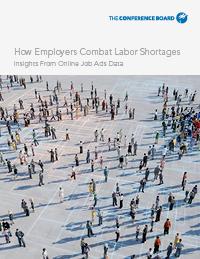Insights From Online Job Ads Data
This report is a collaboration between The Conference Board and Emsi Burning Glass, a leader in collecting and analyzing real-time online job ads. Using online job posting data, we show how employers are combating labor shortages in several dimensions and provide trends and insights to anticipate labor market movements. We also provide solutions for agile firms to navigate the shrinking supply of workers.
To address worsening labor shortages, employers are attracting candidates by offering starting and sign-on bonuses and increasing the transparency of salary information in job ads. They are lowering educational requirements and offering more initial job training.
Insights for What's Ahead
- As bargaining power shifts from employers to workers, companies will not only face higher wage and benefit costs but will need to alter their definition of an ideal new hire. Employers will need to focus on candidates who have competencies such as adaptability and problem solving, and who can work in teams. A new hire with this foundation can be taught the specific and technical aspects of the role. Sacrificing the “perfect fit” and filling skill gaps with training after an employee is hired require investment. However, this investment may provide long-term value by demonstrating the willingness of the organization to invest in their employees’ growth and development.
- Our data show many employers are already lowering formal education requirements in online job ads to fill open positions. Also, the share of postings promoting employer training offerings has increased since 2019, with larger increases beginning in 2021.
- Business leaders need to be clear and decisive about how much remote work will be allowed and in what types of jobs, how hybrid work models will be managed, and where workers can be located. As remote and hybrid workplace models change the recruitment landscape and the way work gets done, future hiring, retention, and innovation will depend on organization-wide clarity around these issues. Flexible work is highly desired by workers and similar in importance to career advancement and better pay. The shift to remote work does provide an opportunity for firms to recruit candidates for white-collar jobs who were previously out of reach, at potentially lower cost. The increase in postings that mention remote work indicates that employers are not only embracing greater flexibility but know it can be a competitive advantage.
- Additional investment in technology and automation, along with skills training, is a viable solution to ongoing labor shortages. Leaders must look ahead and consider how the nature of work will change to get ahead of the talent shortage. The increase in automation and technology has greatly accelerated during the last 18 months as businesses have been forced to think differently about their operating models. This longer-term view will necessitate a continuous reevaluation of the skills needed for people to perform their jobs and drive the creation of new roles that may not exist today but will be essential in the future.
- Ongoing reskilling and upskilling is becoming more important, especially for manual workers. For many manual jobs, employers are having to lower education and experience requirements to meet recruitment goals. As a result, workers are entering the organization with a lower level of proficiency than in the past. Employers should provide ongoing as well as initial training and advertise this training in job ads to make positions more attractive.








 (10).png)




